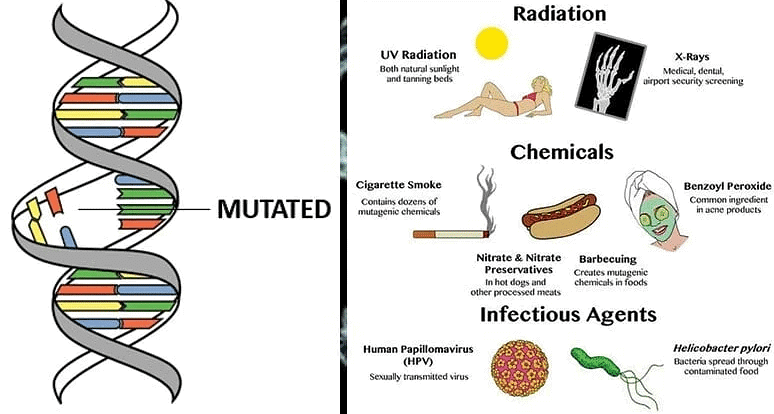Mutations and Mutagenesis | Zoology Optional Notes for UPSC PDF Download
| Table of contents |

|
| Introduction |

|
| Types of Mutation |

|
| Causes and Mechanisms of Mutation |

|
| Agents of Mutations |

|
| Significance of Mutations |

|
| Mutagenesis |

|
Introduction
Mutation is a fundamental biological process that leads to the creation of genes or chromosomes differing from the wild type, which serves as the arbitrary standard for what is considered "normal" for an organism. This process results in a permanent change, most commonly defined as a spontaneous alteration in a gene or chromosome, producing detectable effects in the organism and being transmitted to offspring.

Types of Mutation
- Gene Mutation
- Involves changes in the allele of a gene.
- Chromosome Mutation
- Encompasses changes in segments of chromosomes, whole chromosomes, or entire sets of chromosomes.
Causes and Mechanisms of Mutation
Mutations can occur due to various causes and mechanisms:
1. Errors in DNA Replication
- Mistakes during the DNA copying process.
2. Errors in DNA Repair
- Incorrect repair of damaged DNA.
3. Environmental Mutagen Causes
- External factors causing DNA damage that is not repaired correctly.
4. Transposons and Insertion Sequences
- Mobile DNA elements that can move within the chromosome, potentially causing mutations.
External Causes
Mutations can be induced by mutagenic agents, which can be of physical, chemical, or biological origin.
Physical Mutagens
- Include ionizing radiations such as X-rays, gamma rays, and alpha particles, causing DNA breakage and chromosomal mutations.
Chemical Mutagens
- Various substances, like reactive oxygen species (ROS), deaminating agents, polycyclic aromatic hydrocarbons (PAH), nitrosamines, and industrial solvents like benzene, can increase gene mutability.
Biological Mutagens
- Transposons, viruses, and bacteria can disrupt genetic function through autonomous fragment relocation, DNA insertion, or inflammation-induced DNA damage.
Agents of Mutations
Mutagenic agents induce artificial mutations and can be categorized into physical, chemical, or biological agents. These agents may act directly on DNA or influence replication mechanisms and chromosomal partition.
Significance of Mutations
Study of Traits Transmission
- Variants in genes, caused by mutations, provide insights into the transmission of traits.
Understanding Gene Function
- Mutations serve as valuable tools for studying the function of gene products in biological systems.
Basis for Diseases
- Mutations underlie genetic diseases, including cancer, providing crucial information for diagnosis and treatment.
Genetic Variation
- Gene mutations are the source of most alleles in a population, contributing to genetic diversity.
Evolutionary Driving Force
- Mutations are the raw material for natural selection, playing a pivotal role in the evolutionary process.
Mutagenesis
Mutagenesis refers to the process by which mutations are induced in genetic material through various agents, categorized as physical, chemical, and environmental mutagens. These agents, known as mutagens, can lead to mutations through different mechanisms.
Physical Mutagens
Physical mutagens encompass high-energy radiations that can penetrate living cells and impact genetic material. Two types of radiations, electromagnetic and particulate, exhibit distinct properties.
Electromagnetic Radiations
- Short-wavelength radiations such as X-rays, gamma-rays, and UV rays strongly penetrate cells and tissues.
- The penetration power is inversely proportional to the wavelength.
Particulate Radiations
- Subatomic particles, including alpha particles, beta particles, and neutrons, are emitted from atoms with high energy.
- Alpha and beta particles are charged, with beta particles being more penetrating due to their smaller size.
- Neutrons, uncharged, are highly penetrant and can cause severe damage to living tissues and genetic material.
Ionization and Damage
- High-energy radiations cause ionization in cells, leading to the expulsion of electrons and the generation of free ions.
- Free ions can combine with oxygen, producing reactive chemicals that act on genes, chromosomes, and other cellular components.
- Peroxides, with mutagenic properties, may form in the presence of oxygen, contributing to radiation-induced damage.
Effects of Non-Ionizing Radiations
- UV rays, as non-ionizing radiations, induce the formation of dimers, linking adjacent pyrimidine bases by carbon-to-carbon bonds.
- Dimerization results in intra-strand or inter-strand cross-linking, distorting DNA conformation and affecting normal replication.
Applications and Dose-Effect Relationship
- Many of these radiations find applications in medicine, agriculture, and warfare.
- Understanding the dose-effect relationship is crucial, with experiments suggesting that each doubling of the dose leads to a doubling of induced mutations.
Chemical Mutagens
Chemical mutagens are classified into four groups based on their specific reactions with DNA.
- Base Analogs: Discussed in Section 9.4.5.
- Deaminating Agents: Discussed in Section 9.4.4.
- Alkylating Agents: Examples include EMS, EES, and DES, which add alkyl groups to DNA bases, leading to mispairing or loss and subsequent mutations.
- Intercalating Agents: Include ethidium bromide and Acridine dyes, which mimic base pairs, leading to the opening of the DNA helix and causing deletion or addition of base pairs during replication.
Environmental Mutagens
Environmental mutagens encompass air and water pollutants, agricultural chemicals, pesticides, and industrial smoke, including carcinogenic chemicals like Benzidine and Vinyl Chloride. Urban air pollutants, such as fine particulate matter, have demonstrated mutagenic effects. Additionally, certain biological agents, including transposons, viruses, bacteria like Helicobacter pylori, and parasitic fungi of field crops, can act as mutagens by inducing inflammation and DNA damage, ultimately leading to mutations.
|
198 videos|351 docs
|




















